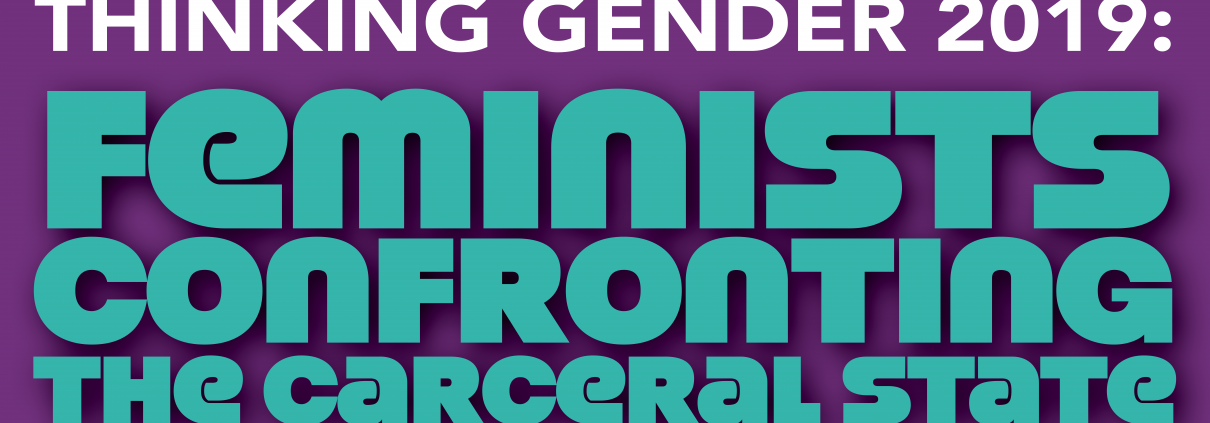Thinking Gender: Feminists Confronting the Carceral State, with reflection and gratitude
By Kali Tambreé
On February 22, 2019, the Center for the Study of Women welcomed 34 student presenters from 24 colleges and universities across the country to Thinking Gender 2019: Feminists Confronting the Carceral State. These brilliant and creative scholars shared their timely work with each other and Thinking Gender attendees. I was overwhelmed by the breadth of approaches and depth of attentiveness of their work, and left many sessions introduced to new materials, current campaigns, buried histories, and processing crucial connections. Abolitionist work may be grounded in a particular, explicit politic, but can clearly take many forms and expressions. What is consistent is a commitment to articulating and imagining an anti-carceral world, while prioritizing work that centers the humanity and the tangible needs of those entrapped by carceral regimes, broadly defined, now.
Our keynote panel revealed just how vital these priorities are. The panelists, Alisa Bierria (Survived & Punished), Colby Lenz (Survived & Punished), Romarilyn Ralston (Project Rebound), and Beth Richie (University of Illinois, Chicago) and moderator, CSW Advisory Committee Chair Grace Hong, had an engaging and challenging conversation about the stakes of futures of abolitionist feminist activism and scholarship. In front of an audience of over 230 people, they each articulated the most pressing issues they are organizing around, and contextualized these concerns in a larger constellation of abolitionist activism past, and present. A number of these scholars emphasized that they identify as activists first, and, while not diminishing the impacts of their scholarship, centered the importance of the material needs of formerly, and currently incarcerated peoples. Perhaps the most crucial challenge they left the audience with is to achieve a sense of clarity on what an abolitionist practice truly entails beyond the conceptual, or theoretical affiliation or identity. Abolitionist praxis must extend beyond the classroom, and cannot exist only in name. The task of abolitionist feminists is to maintain the centrality of life. What is needed right now to affirm and support to lives of those who are placed in close proximity to precarity? How can the long-term vision of abolition center life, and livability? What are the urgent needs of those currently detained? What is our vision of a world where lives and communities are indispensable? What is our vision of a world where responses to harm are not dictated by punishment, containment, disappearance, and violence?
The realities shared and exchanged throughout the conference panels, roundtables, and keynote panel were contextualized in a pop-up visual exhibit that included historical and contemporary photos, posters, and videos that documented gendered regimes of incarceration, detention, police violence, and settler colonialism and strategies for resistance. This exhibit provided an opportunity to engage with histories of carcerality beyond oral scholarly presentation, and emphasized the continuities between various interconnected regimes and practices of colonialism, slavery, incarceration, detention, and surveillance. We intentionally organized the exhibit to show continuity across sites and histories of carcerality. As a scholar of transatlantic slavery, I am particularly attentive to how the practices of surveillance, caging, and physical and sexual violence of plantation slavery re-emerge in the current carceral system. You can trace the punishment and caging of Black girls from convict leasing camps, to Danny Lyon’s documentation of girls incarcerated for participating in civil rights protest in the 60s, to Korryn Gaines’ premature death at the hands of Baltimore County police just miles from my home in Baltimore City. Our purpose was not to recreate scenes of subjection, but rather to demonstrate that the carceral landscape that produced the conditions for Korryn Gaines’ murder is not a modern invention, but an expression of the nation as it was intended to function. The sites of life and resistance embedded in these images and videos are not simply in response to perpetual violence, but actually indicative of communities constituted by repair, protection, accountability, and love. The keynote panelists, graduate student presenters, and faculty moderators echoed these sentiments expertly.
Ultimately, Thinking Gender: Feminists Confronting the Carceral State was a beautiful, immense, challenging, and stimulating conference. I am deeply grateful to all that contributed formally and informally, and intend to continue to bolster opportunities for spaces that share a radical vision of feminist abolitionist futures.




